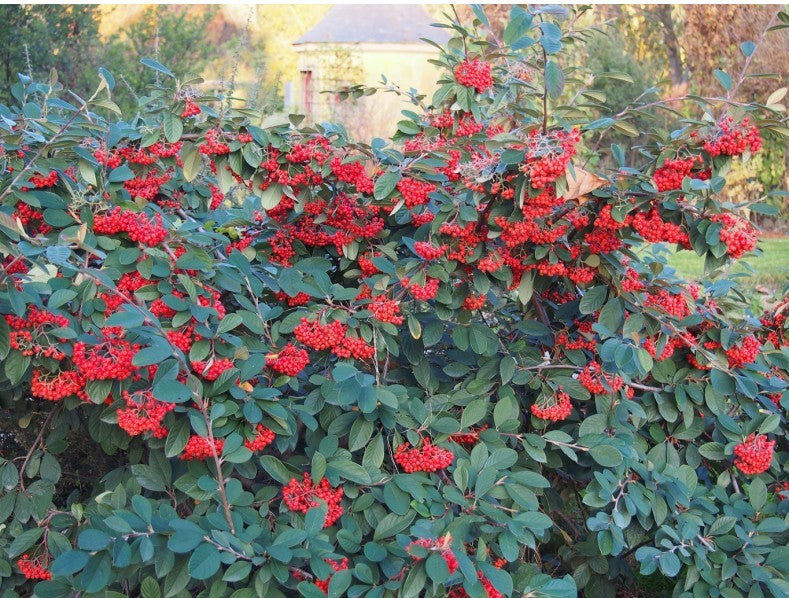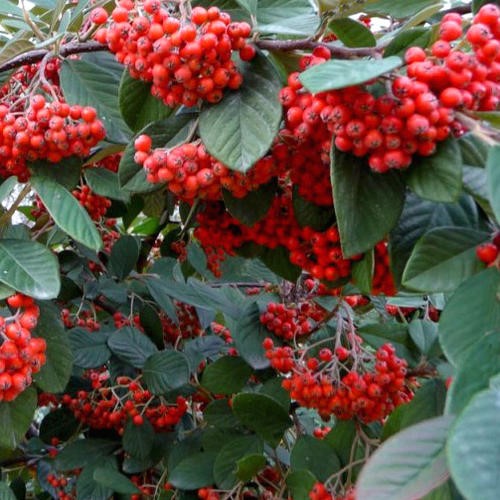by Ken Lain, the mountain gardener

Red Cluster Berry Cotoneaster, Cotoneaster lacteus, is a graceful arching shrub perfect for natural, low-maintenance landscapes. Plants grow quickly to head height with an informal, organic form. The small oval leaves are dark green with pale green undersides. In fall, the foliage turns a deep purple color, which offers a striking contrast to the clusters of bright red berries. Before the berries emerge in fall, plants produce loads of small white blooms in spring. Butterflies and bees are highly attracted to the tiny flowers. This is an excellent plant if you want to add year-round interest to your landscape. It is often used on slopes for erosion control, as an accent plant, and informal hedges. Plants perform best in 6+ hours of full sun location and can tolerate a variety of soil. Plants have low to moderate water needs once established and prefer good drainage.
Botanical Name Cotoneaster Parneyi
Common Name Red Cluster Berry Cotoneaster, Milkflower Cotoneaster, Parney Cotoneaster
Plant Type Evergreen shrub
Mature Size 8′ ft. tall X 9′ ft. wide
Spacing 5′ centers for hedge
Sun Exposure 6+ hours of Full sun
Soil Type Average, well-draining
Soil pH 6 to 8 pH
Bloom Time Spring
Flower Color White, in clusters 2″ to 3″ across
Berries Red Summer through Winter
Water Low to moderate
Hardiness Zones 6 to 10
Planting Time Any Season
How to Plant and Grow Red Cluster Berry Cotoneaster
The largest of cotoneasters has many uses in landscaping, including hedges, privacy screens, and specimen plantings. This cotoneaster is so tolerant of salt, it can be used near sidewalks, driveways, and roadways. It is rarely damaged by animals, such as rabbits, deer, javelina, elk, and pack rats.
Ensure the location has excellent drainage and gets at least six hours of sun during the growing season. Red Cluster Berry Cotoneaster has the same cultural needs as most other cotoneaster species. Container-grown plants should be planted in a large, carefully prepared hole and backfilled with soil amended with Watters Premium Mulch or another acidifying organic material.
Light
Red Cluster Berry Cotoneaster grows best in full sun. It prefers at least six hours of direct sunlight each day.
Soil
This plant is tolerant of many different soil types, including sandy, rocky, and clay soils. It does best in average garden soil with a neutral to slightly acidic pH. Good soil drainage is critical.

![]() Water
Water
Along with adequate drainage, Red Cluster Berry Cotoneaster grows best in moderately moist soil. Irrigate young plants twice a week to maintain soil moisture. Once cotoneaster is established, it becomes tolerant of dry soil and drought.
Temperature and Humidity
Red Cluster Berry Cotoneaster is exceptionally robust in frigid temperatures and well suited for USDA zones 6 to 10, hardy down to zero degrees Fahrenheit. This species prefers cold temperate climates. The plant is tough in dry conditions, as long as its roots aren’t sitting in soggy soil.
Fertilizer
Feed with Watters 7-4-4 All Purpose Food 3 times per year (March, July, and October) for best blooms and dense foliage that screens and cuts the wind.
Pruning
Pruning is typically best done annually in the late winter or early spring, just before growth begins in March. Prune dead, broken, or diseased branches. Next, trim back leggy branches to maintain the plant’s shape. Aim to selectively prune branches around the entire plant to increase the amount of light that can reach its center.
Red Cluster Berry Cotoneaster is very forgiving of pruning mistakes. So if you prune a bit too much, just give the plant a little growth time to correct your error.
How to Plant a Red Cluster Berry Cotoneaster
Companion Plants with Red Cluster Berry Cotoneaster for a Stunning Backyard
Arizona Cypress
Austrian Pine
Mint Julip Juniper
Boxwood
Yew

